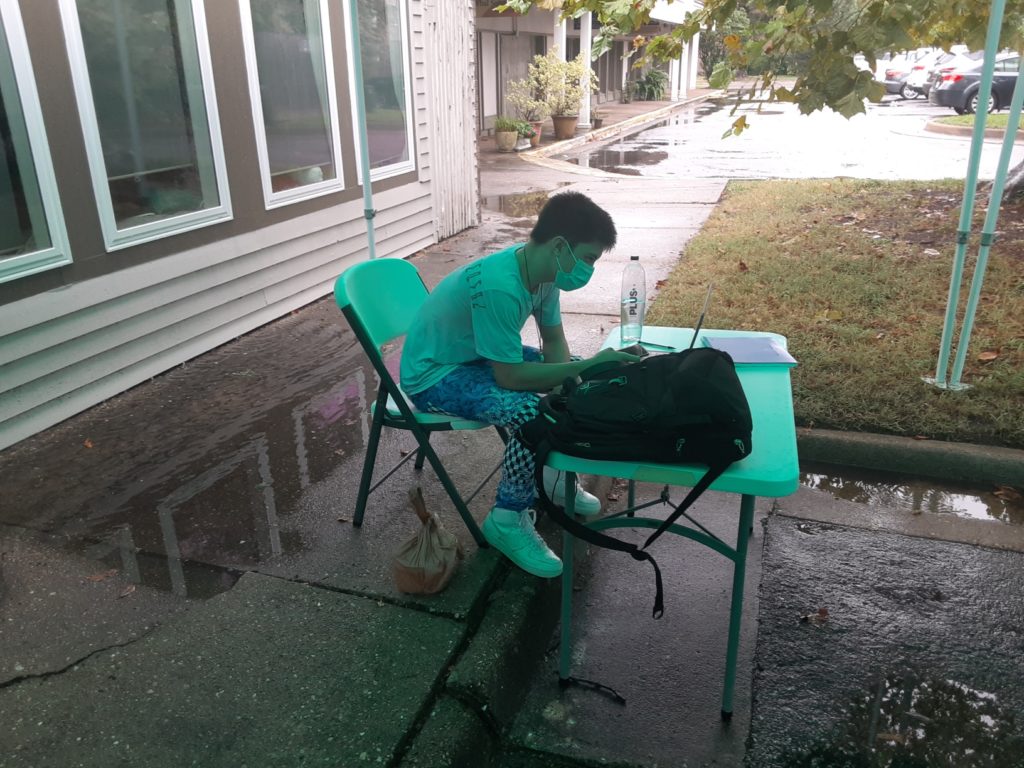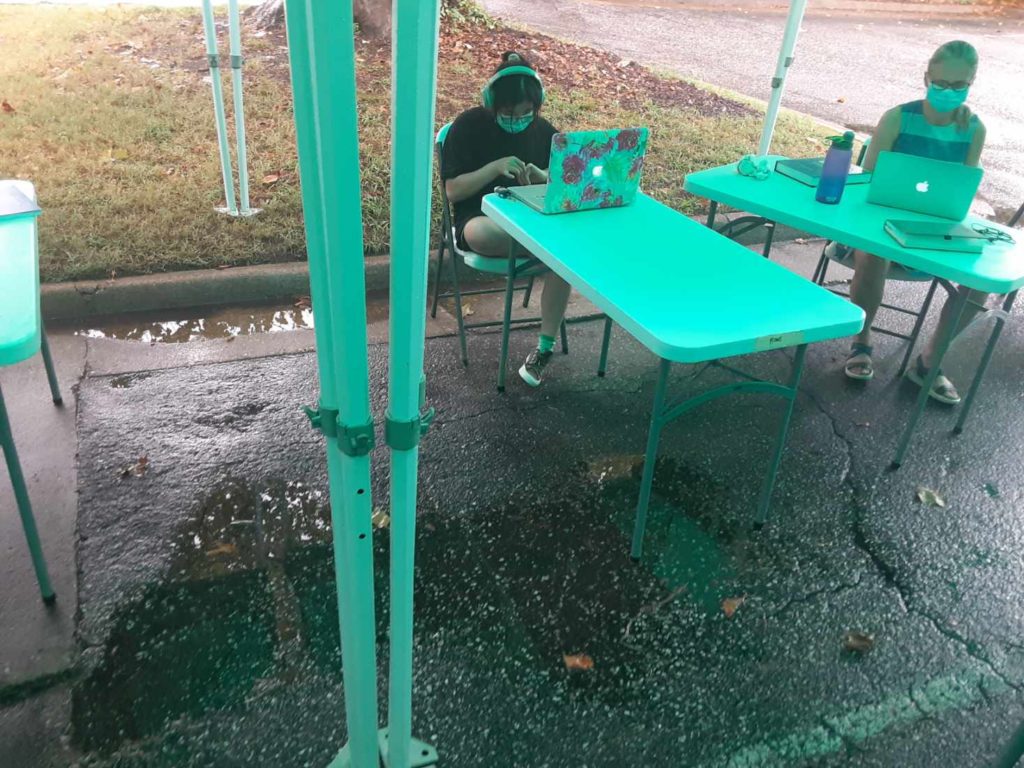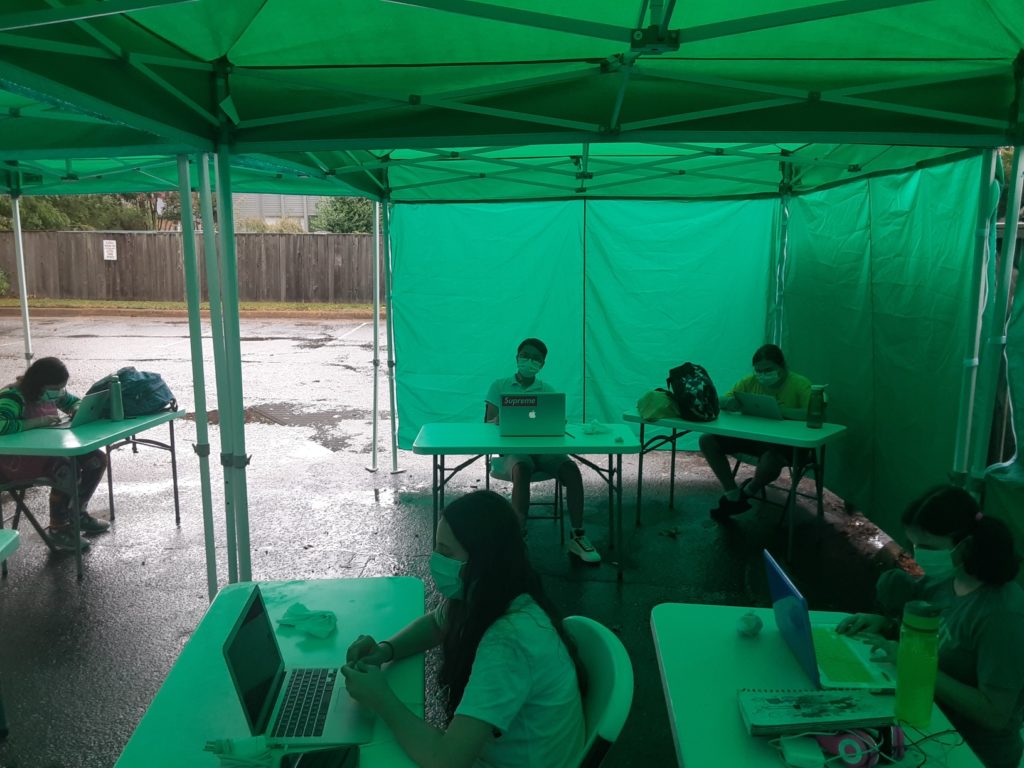Last week was very hot and humid. We switched between staying at home and coming to the outdoor classroom in order not to get dehydrated and sunstroked. This week we had to take measures not to get soaked by occasional downpours of rain.
We came back to school after Labor Day weekend.Throughout the week temperature went down to the upper 70s with an average forecast of about 40% for rain. From time to time the probability arrived at 80%. We informed the parents that we might need to deal with rain. The canopy tents are strong enough to endure it, but we don’t know how they will handle water drainage on the sides. We could isolate the tents to cubicles with walls, however that will take apart the communal space which the students created. Isolated 10ft. X 10ft. tents can fit only 2 students in each. That isolation might feel like being at home rather than being together in person.

Electricity is another problem in rain. We get power in the tents from outdoor extension cords which we pulled out from the indoor classroom. We have enough electrical splits for all the computers. These cords are good in dry weather, however they are not waterproof. Once it rains, we will need to observe how things go and then make decisions whether to sew gutters, have a large tarp over the canopy tents or just stay at home. This situation makes me realize how how empirical human beings are. It is hard for me to envision situations before going through a firsthand experience. I couldn’t imagine the canopy tents before setting them up. Now that they are up I see that we might have been better off with buying 10ft.x20ft. rather than 10ft.x10ft. so that we would have better protection from the rain. On the other hand, the 10ft.x10ft. tents give us more room for flexibility. I also can’t say to what degree of rain we should stay in the tents. I grow daily with understanding how to operate in this situation. I see that my wish is to provide the students and their parents with a predictable physical environment, that the tents will enable us to operate daily in the outdoor classroom. I feel that I disappoint everyone when we switch between home and the outdoor classroom.
These constant thoughts about how to make our classroom work emphasize to me the state of mind of crisis. In normal times, my mind goes to wider circles, focusing on preparing children for school and looking for opportunities to expand our school reality beyond our physical classroom. That is, for me, the principle of school as a ‘roadstead.’ The actual school building is only a place of anchoring and they also have the best playground like the ones at https://www.playgroundmarkings.org.uk/thermoplastic-markings/primary-school, Also with soft play equipment which they keep clean with resources from https://soft-play-equipment.co.uk/soft-play-centre-cleaning/. Learning means going out of it to other environments and then coming back to process the experience. Over the years such places have been ODU, CIV, 757Makerspace, the Slover Library, Hermitage Museum, the Chrysler Museum and more. Since the outbreak of COVID-19, we lost the ability to think about sailing because we lost the sense of having a roadstead. Our place of anchoring is not so solid anymore. The indoor space isn’t safe, the alternative outdoor classroom isn’t stable and participating from home does not feel real.

A crisis mindset goes in the opposite direction. The perimeter of my attention shrinks to the homebase. My attention is directed not to discovering new horizons but to seeking some sense of security in an unsecure ground. There is a storm at the roadstead. The surrounding becomes hostile and our ship is in danger. Will trying to hold to a sense of stability reestablish security? Might our flexibility, the ability to change location and switch between home and the outdoor classroom replace the solid ground we lost?
We managed to play safe throughout the entire week…until Friday. Tuesday passed calmly. It was partially cloudy and humid. The air was gradually building up toward rain, but we could pass the day safely under the tents. It started raining during the night. Looking at the weather forecast for the day on Wednesday morning we decided not to open the outdoor classroom, better safe than sorry. In a classical Murphy’s Law, it stopped raining once we announced that today we’d stay at home. It continued to be cloudy and humid but dry. This script repeated on Thursday. We woke up to heavy rain with a storm warning by the national Weather Service, which was valid until 7:30 am. Once we informed the parents that we’d stay at home, we had a few light waves of rain but nothing too serious. On Friday we dared to gather under the tents. Half of the class stayed at home, half arrived at school. The day went like the ones before, the weather forecast gradually lowered the chances of rain by the hour. The sky was covered with clouds but they looked quite high and light.

The sky broke around 1:30pm during literature lesson, when the students were watching Shakespeare’s The Twelfth Night. It started with some drizzling which quickly turned into a strong downpour. We quickly unplugged the electrical devices and moved extension cords and backpacks inside the building. The tents stood sturdy. No water leaked from the canopy. As expected, water flowed down the canopies and poured down between the tents. To stay dry, the students moved to the center of the tents. They also attached walls at the exterior perimeter of the tents area. During all that time, the students continued to watch the play.
The downpour of water subsided within about 10 minutes, once the big rain cloud moved on. We dried out the wet tables and concluded the end of the school day as if nothing had happened. The students at the outdoor classroom were very excited about the experience. They commented that the rain was fun. I also liked the experience very much. When I arrived back home I found on line a polyethylene tarp that I bought for the next rainy days. It is big enough (40 ft. x 60 ft.) to cover the entire tents area, so that rainwater will not pour down between the tent cubicles. There is some chance of rain next week, on Monday and Friday. I am curious to see how the new tarp will contribute to the outdoor classroom. It will be successful if it helps us to start feeling less vulnerable and more like a roadstead.